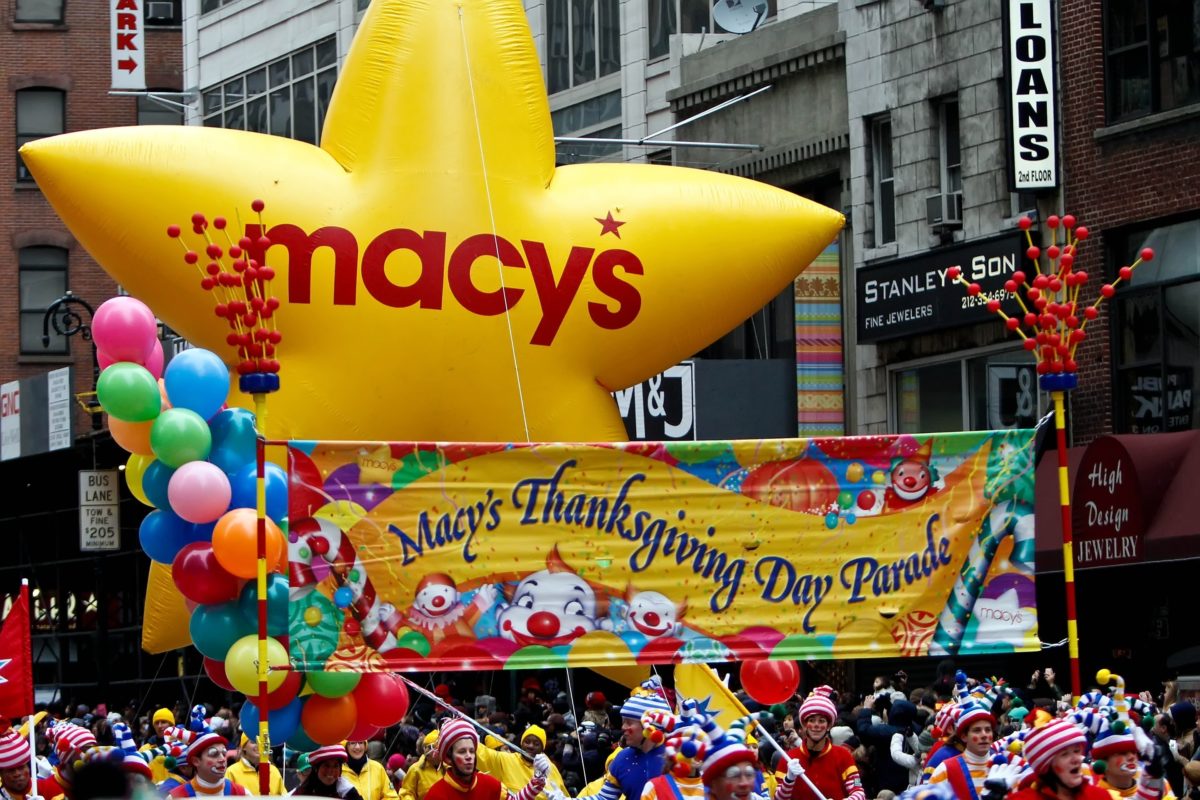
Parsing Through the Costs of the Macy’s Thanksgiving Day Parade
Originating as “Macy’s Christmas Day Parade” with live animals in 1924, the modern Macy’s Thanksgiving Day is a cherished hallmark of our country, garnering millions in both views and dollars every year.
Costing anywhere from $10 million to $13 million in production cost on an annual basis, families have a tradition of remaining glued to the TV as they watch wondrous floats followed by dizzying dancers and famous musical artists take spotlight after spotlight.
However, up until this year — when Peacock officially grabbed at the opportunity to be the one and only streaming platform to feature the parade — the event only aired on broadcast television, leaving marketers wondering whether it was worth the cost of sponsorship in a world that has been increasingly concerned with digital consumerism.
Our take on it? Absolutely, it still pays off. Here’s what to keep in mind:
The “Why”
Let’s face it: The Macy’s Thanksgiving Day Parade is here to stay.
Most would agree that simply partaking in the parade is an honor, offering companies the opportunity to showcase their commitment to American ideals and unity. And what better way to boost your brand reputation than to contribute to a national sense of holiday joy?
But warm and fuzzy sentiments aside, the reason a company might choose to participate as a sponsor of the Macy’s Thanksgiving Day Parade is simple: for the sheer amount of views they’ll amass.
This year, “NBC’s coverage of the Macy’s Thanksgiving Day Parade drew a total of 25.4 million total viewers and a 6.4 rating in the adults 18-49 demographic on Thursday across the live broadcast and encore immediately after,” according to Deadline.
What’s more, with holiday shopping on the horizon for most households, even an ephemeral appearance of your brand’s logo on a float may be all it takes to plant a spending seed in the mind of your potential customers.
The “How Much”
As large companies generate considerable returns on their investment following the Thanksgiving Day Parade, it makes sense that many would clamor to purchase ad space while the renowned parade airs live.
“In 2019, the network generated an estimated $49.2 million in ad revenue from the Macy’s Thanksgiving Day Parade, while The National Dog Show brought in $11.7 million and the prime-time NFL game … yielded $72.1 million,” as reported by AdWeek. “That’s close to $133 million in ad revenue for the three events.”
And comparing that to the aforementioned $13 million production price tag? Well, yeah, let’s just say that’s not bad at all.
That being said, for those looking to skip the traditional commercial ads and actually be recognized in one of the nation’s most beloved and non-controversial events of all time, businesses may also opt to sponsor the balloons themselves.
In fact, according to CBS News, brand new parade balloons cost sponsors approximately $200,000 each, or nearly $90,000 should they sponsor a returning balloon.
The Bottom Line
Okay, so maybe your business isn’t quite ready to tackle the Macy’s Thanksgiving Day Parade, but that doesn’t mean you can’t hold onto it as a big audacious goal of your own.
And if you’re ready to embark upon the journey that will carry you into the right direction of growth, Mad Men Marketing can help you get there!
After all, here at Mad Men Marketing, we are rooted in the belief that brands should interact with their customers, not interrupt them. And what better way to grow than to have measurable goals and research experts at your fingertips? From traditional marketing expertise to digital strategy, social media engagement and more, our team is ready and waiting to reach new heights of gratitude and success.
So, if you’re ready to learn more, contact Mad Men Marketing today by calling (904) 355-1766!
The Rise of Social Commerce (s-Commerce)
We've seen companies like Amazon and Facebook transition from a laser-focused CD and movie source and social media network respectively, into multi-faceted money making machines. Amazon has positioned itself as THE online marketplace in the United States and has diversified into other web services like hosting and marketing as well as developing its own distribution infrastructure to the point that it can rival virtually any logistics company and it has its sights set on grocers too.
Meanwhile, Facebook has gone from cool collegiate exclusivity to the most ubiquitous social channel in the world. Recently, Facebook revealed that it would amplify its existing e-commerce ads to account for showcase shopping ads. Just like Google, Facebook is taking advantage of their online resources to help advertisers push more merchandise just in time for holiday shopping. The new ad format allows advertisers to display one main picture with several product images that would, ostensibly, have their own unique landing pages. This gives the potential consumer a broader understanding of what the retailer may be selling and what's specially priced.
Pandora's box is open and there's no going back. Linking a bank account to everyone's personal Facebook page isn't far off and this may raise security concerns all over the world, but for now, social media will undoubtedly see a rise in sell-through, especially with reasonably priced impulse buys. It will continue to command an ever-increasing amount of your advertising budget as their ads evolve in terms of what can be done with them creatively and who can be targeted strategically. Currently, only a few heavy hitters are testing out the new format, but look for a wider roll-out soon with other companies following suit in 2017. Admittedly, I laughed derisively when some people claimed that Facebook was coming for Google. Well, it appears that not only do they want to compete with Google, but with Amazon and Alibaba as well. What's more is that they seem to have the golden touch right now and I wouldn't put anything past them.
Mobile Evolution: The Rise Of The Pocket Economy
At the turn of the millennium, the internet changed the way companies in general did business. The dawn of the digital age brought many companies to their collective knees, creating a life-or-death scenario for those who were slow to take the on-ramp to the Information Superhighway and completely reshaping entire industries. There was a mass extinction of many brick and mortar businesses, seismic shifts in how music & television is produced and consumed (ask a millennial what the last CD they bought was, and you're apt to get a puzzled look) and a vast frontier of new and emerging business opportunities in fields that were being created in response to these new and exciting technologies.
The rate at which new technology has been introduced to the masses has historically outpaced the rate at which companies can utilize it.
Here we are in 2016, standing at the precipice of another big shift in “tech-tonic” trends and this time, more businesses are preparing to go to war. The weapon of choice will be the most advanced way to target the masses while still finding ways to target individuals across demographics: mobile advertising.
It’s forecasted that by 2020, mobile advertising will account for nearly 75% of all digital ad spends. While desktop ads still get their share of the current digital spend, the rate at which companies have been shifting gears to focus more on mobile advertising has grown to the point where 2016 should be the year that mobile surpasses desktop, and once that happens, there will be no looking back.
The Golden Apple
AT&T will no longer be a part of the 30 companies counted toward the calculation of the Index. This comes on the heels of a 7-1 stock split by Apple, which lowered the price/share to a much more reasonable $125. Apple is one of, if not THE most valuable company out there and it will no doubt rev up the DOW engine, and potentially bloat the index initially. I can't help but be excited even though I know the metrics will be somewhat skewed initially. This is an exciting time as numbers in most major indexes are seeing record numbers. Some will say that this is a bubble nearing an explosion, but on the other side of that spatial model, they will tell you that the DOW could approach 23,000 within a year or two. The truth may lie somewhere in the middle. Whatever the case may be, I look forward to what is to come of it.
Tradition vs Evolution: Go Team….Go?
Many top-tier Div. I football programs fund the bulk of their entire university athletic departments, or at least support athletic programs at their schools that cannot or would not be able to support themselves otherwise. They often bring a significant amount of business to the towns that host their games as well. The impact is especially great in smaller cities.
In 2013, the University of Nebraska paid $2.1 million to the University of Southern Mississippi to move their match-up from Hattiesburg to Lincoln. This move increased the Huskers game day revenue by 14%, and brought an estimated $8 million to the local economy (forbes.com, December 2012). While Southern Mississippi reaps the benefits of the venue change, the local economy in Hattiesburg will not see any of the influx of revenue that it would have enjoyed from visiting Husker fans.
West Virginia paid $20 million to leave the Big East (a conference made up mostly of east coast teams, as the name would suggest) and join the Big-12 (teams based primarily across the central states), which had just secured a lucrative media contract with ESPN and Fox, to the tune of $2.6 billion. While television deals are a boon to conferences, schools individual earnings remain the driving force behind their overall financial success.
Teams are willing to eschew decades of tradition to enhance their economic futures. The opportunity for increased revenue and brand growth outweighed the decades of economic ties between teams and communities that benefited mutually from long-standing, yearly rivalry match-ups.
These efforts to expand brand awareness, whether through marketing themselves to recruits in new territories by moving to a more prestigious athletic conference, or expanding their fan base by endeavoring into new territories, shows that teams are willing to embrace non-traditional methods of evolving their business models in an effort to ensure continued fiscal success in the years to come.


